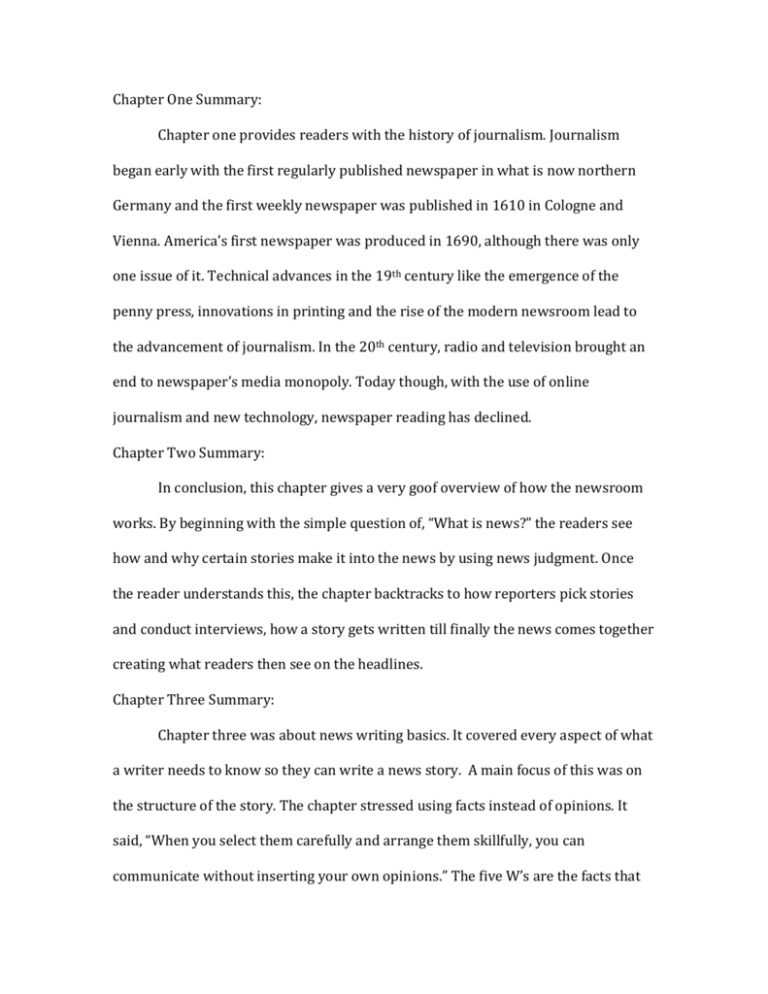Journalism Chapter Summaries: History, Writing, Reporting
advertisement

Chapter One Summary: Chapter one provides readers with the history of journalism. Journalism began early with the first regularly published newspaper in what is now northern Germany and the first weekly newspaper was published in 1610 in Cologne and Vienna. America’s first newspaper was produced in 1690, although there was only one issue of it. Technical advances in the 19th century like the emergence of the penny press, innovations in printing and the rise of the modern newsroom lead to the advancement of journalism. In the 20th century, radio and television brought an end to newspaper’s media monopoly. Today though, with the use of online journalism and new technology, newspaper reading has declined. Chapter Two Summary: In conclusion, this chapter gives a very goof overview of how the newsroom works. By beginning with the simple question of, “What is news?” the readers see how and why certain stories make it into the news by using news judgment. Once the reader understands this, the chapter backtracks to how reporters pick stories and conduct interviews, how a story gets written till finally the news comes together creating what readers then see on the headlines. Chapter Three Summary: Chapter three was about news writing basics. It covered every aspect of what a writer needs to know so they can write a news story. A main focus of this was on the structure of the story. The chapter stressed using facts instead of opinions. It said, “When you select them carefully and arrange them skillfully, you can communicate without inserting your own opinions.” The five W’s are the facts that should be included in a news story. This includes, the who, what, when, where, and why. The text focused on the inverted pyramid as the best way to take these facts and makes them into a story. The inverted pyramid is a writing style that has the lead summarize the most important facts and the following paragraphs continue to add more detail and background. The main focus of the inverted pyramid is placed on the lead. The lead needs to be a summary of the 5 W’s but needs to be interesting enough to make readers want to read on. There are many types of leads. Some of these include the basic news lead, which is either a summary of what the story is about or one that is a summary but withholds a significant piece of information that will make readers want to keep reading. There are anecdotal/narrative leads that unfold slowly. The scene setter leads sets the stage for what the story is about. A more creative way of writing leads can be with beginning with a startling statement or a play on words. After the lead, the next paragraphs should expand on what has already been said and add more detail. A brief, a brief version of a story, is a good, way to begin to learn to write. After the story is complete, the writer should reread it and rewrite it to make it better. Also it should be edited with the AP style book to make sure everything is correct. Chapter Four Summary: Chapter four covers the basics of reporting. This includes, where stories come from, information on sources, ways to take notes, the proper use of quotes, and how to use charts to display data correctly. Smaller focuses included how to write a follow up second day story, which further analyzed what happened, what it means and what is next as compared to an advance. In an advance, the author explains the who, what, where, why for readers ahead of time. Another focus included the importance of diversity. This section made sure to inform future writers that focusing a story on Hindus doesn’t fully make it diverse but instead the author should use a Hindu family, like it does a white family, when interviewing them on an average story about hybrid cars for example. Chapter Five Summary: Chapter five is about covering the news. It gives descriptions of how to cover beats, obituaries, accidents and disasters, fires, crime, courts, speeches, meetings, politics, and sports. Most reporters are assigned to beats, which covers schools, crime, sports and business. Obituaries should be written like mini biographies, it should be about life, not death so that it honors and inspires. This means past personal problems should not be brought up, flowery phrases should be avoided and the cause of death should only be included if it is not embarrassing. Accident stories should include the victims, the extent of injury or cause of death, cause of accident, location, time, circumstances, vehicles, arrests or citations made by the police, comments from police and witnesses and acts of heroism. Disasters should be covered by going to where the action is and talking to victims and eyewitnesses. Fires should include a lot of the same details that would be included in an accident story. The bigger the fire, the bigger the story. Crime should also include information about the time, place, victims and severity and police and eyewitnesses and victims. When covering courts, the writing should remain neutral and know the background of the case. Speeches and meetings should involve note taking during them and research before to understand the background of what is going on. When covering politics, key aspects the reporter should cover include decision-making, the election process and money. Facts that you can trust should come from speeches, meetings, news releases and conferences. Finally, when covering sports, the writing can be more casual but still requires accuracy and insight. -










